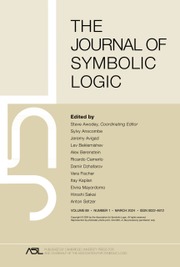Crossref Citations
This article has been cited by the following publications. This list is generated based on data provided by Crossref.
SORBI, ANDREA
WU, GUOHUA
and
YANG, YUE
2010.
Diamond embeddings into the enumeration degrees.
Mathematical Structures in Computer Science,
Vol. 20,
Issue. 5,
p.
799.
Ganchev, H.
and
Soskova, M.
2012.
Embedding distributive lattices in the Formula enumeration degrees.
Journal of Logic and Computation,
Vol. 22,
Issue. 4,
p.
779.
Goh, Jun Le
Lempp, Steffen
Ng, Keng Meng
Soskova, Mariya I.
Brattka, Vasco
Greenberg, Noam
Kalimullin, Iskander
and
Soskova, Mariya
2022.
Extensions of two constructions of Ahmad.
Computability,
Vol. 11,
Issue. 3-4,
p.
269.
KALIMULLIN, ISKANDER SH.
LEMPP, STEFFEN
NG, KENG
and
YAMALEEV, MARS M.
2024.
ON CUPPING AND AHMAD PAIRS.
The Journal of Symbolic Logic,
Vol. 89,
Issue. 3,
p.
1358.

